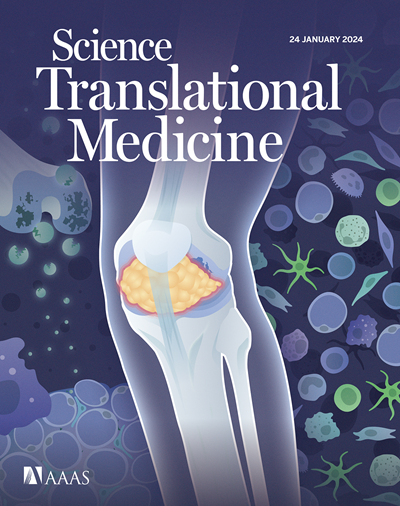攀爬纤维去神经支配降低小脑节律与小鼠运动节律缺陷和患者共济失调严重程度有关
IF 15.8
1区 医学
Q1 CELL BIOLOGY
引用次数: 0
摘要
小脑共济失调是由各种遗传和非遗传疾病引起的,其特征是不自主运动损害精度和运动节奏。在这里,我们报道攀登纤维(CF)去神经支配是小脑共济失调中运动节律丧失的常见病理生理学。通过检查脊髓小脑共济失调(SCA) 1、2、6型和多系统萎缩患者的小脑病理,我们发现CF变性伴突触丧失是一种共同的病理生理学。光遗传沉默小鼠CF突触活性诱导共济失调样运动功能障碍和运动精度丧失。此外,CF沉默导致小脑和运动节律丧失,这是共济失调的另一个核心特征。这种节律丧失主要是CF依赖性的,并且对白喉毒素引起的浦肯野细胞特异性损伤具有抗性。相应的,两名下橄榄病理患者(为浦肯野细胞提供CFs的脑部位)表现为共济失调和小脑节律丧失。遗传性或非遗传性小脑共济失调患者表现出小脑节律丧失,与共济失调评定评定量表相关。在SCA 1型共济失调小鼠模型中,CFs的化学发生刺激改善了小脑和运动节律以及运动表现。这些结果表明,cf依赖性小脑节律丧失发生在不同类型的小脑共济失调中,导致运动不精确和运动节律丧失,这是共济失调的两个定义特征。本文章由计算机程序翻译,如有差异,请以英文原文为准。
Reduced cerebellar rhythm by climbing fiber denervation is linked to motor rhythm deficits in mice and ataxia severity in patients
Cerebellar ataxia results from various genetic and nongenetic disorders and is characterized by involuntary movements that impair precision and motor rhythm. Here, we report that climbing fiber (CF) denervation is a common pathophysiology underlying motor rhythm loss in cerebellar ataxia. By examining cerebellar pathology in patients with spinocerebellar ataxia (SCA) types 1, 2, and 6 and multiple system atrophy, we identified CF degeneration with synaptic loss as a shared pathophysiology. Optogenetic silencing of CF synaptic activity in mice induced ataxia-like motor dysfunctions and loss of motor precision. In addition, CF silencing resulted in cerebellar and motor rhythm loss, another core feature of ataxia. This rhythm loss was predominantly CF dependent and resistant to Purkinje cell–specific lesioning by diphtheria toxin. Correspondingly, two patients with inferior olive pathology, the brain site that provides CFs to Purkinje cells, presented with ataxia and cerebellar rhythm loss. Patients with genetic or nongenetic cerebellar ataxia exhibited cerebellar rhythm loss that correlated with the Scale for the Assessment and Rating of Ataxia. Chemogenetic stimulation of CFs improved cerebellar and motor rhythms as well as motor performance in the SCA type 1 mouse model of ataxia. These results suggest that CF-dependent cerebellar rhythm loss occurs across different types of cerebellar ataxia, contributing to motor imprecision and motor rhythm loss, two defining features of ataxia.
求助全文
通过发布文献求助,成功后即可免费获取论文全文。
去求助
来源期刊

Science Translational Medicine
CELL BIOLOGY-MEDICINE, RESEARCH & EXPERIMENTAL
CiteScore
26.70
自引率
1.20%
发文量
309
审稿时长
1.7 months
期刊介绍:
Science Translational Medicine is an online journal that focuses on publishing research at the intersection of science, engineering, and medicine. The goal of the journal is to promote human health by providing a platform for researchers from various disciplines to communicate their latest advancements in biomedical, translational, and clinical research.
The journal aims to address the slow translation of scientific knowledge into effective treatments and health measures. It publishes articles that fill the knowledge gaps between preclinical research and medical applications, with a focus on accelerating the translation of knowledge into new ways of preventing, diagnosing, and treating human diseases.
The scope of Science Translational Medicine includes various areas such as cardiovascular disease, immunology/vaccines, metabolism/diabetes/obesity, neuroscience/neurology/psychiatry, cancer, infectious diseases, policy, behavior, bioengineering, chemical genomics/drug discovery, imaging, applied physical sciences, medical nanotechnology, drug delivery, biomarkers, gene therapy/regenerative medicine, toxicology and pharmacokinetics, data mining, cell culture, animal and human studies, medical informatics, and other interdisciplinary approaches to medicine.
The target audience of the journal includes researchers and management in academia, government, and the biotechnology and pharmaceutical industries. It is also relevant to physician scientists, regulators, policy makers, investors, business developers, and funding agencies.
 求助内容:
求助内容: 应助结果提醒方式:
应助结果提醒方式:


